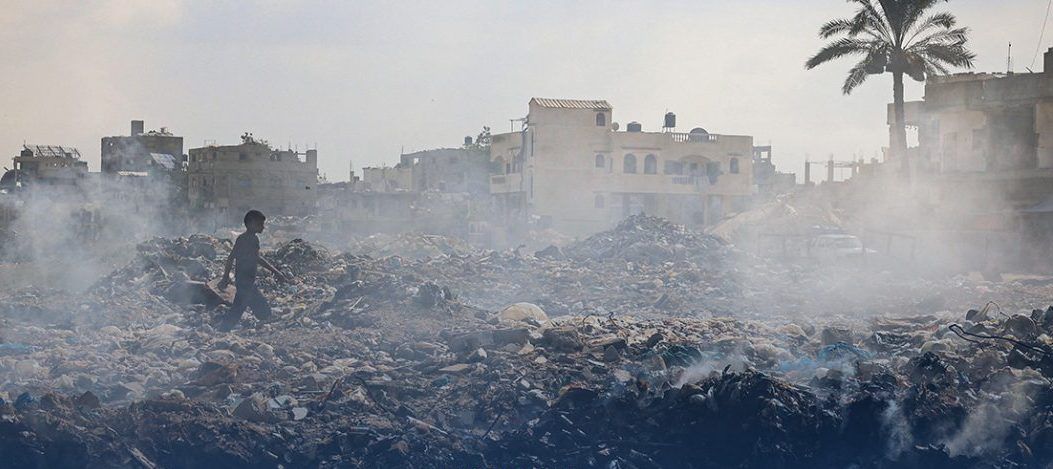- Home
- Arab World
- US Tells Top Israeli Officials Gaza Civilian Toll "Unacceptably High"

©(Eyad BABA/AFP)
US Secretary of State Antony Blinken told two top Israeli officials Monday of the "unacceptably high" civilian casualties in Israel's bombardment of the besieged Gaza Strip, his spokesman said.
The Israeli military has launched several deadly attacks in recent days including on a refugee camp and multiple UN-run schools where civilians were sheltering.
In response, Hamas said it was pulling out of ceasefire negotiations, causing prospects for a truce and hostage release deal to dwindle further.
Blinken received two influential Israeli officials - Strategic Affairs Minister Ron Dermer and National Security Advisor Tzachi Hanegbi - "to express our serious concern about the recent civilian casualties in Gaza."
"Casualties still remain unacceptably high. We continue to see far too many civilians killed in this conflict," State Department spokesman Matthew Miller told reporters.
On Saturday, Israeli strikes killed more than 90 people in the Al-Mawasi camp near Khan Yunis, the Health Ministry in Hamas-run Gaza said.
AFP reported sirens wailing and women screaming as children were pulled bloody and unmoving from the wreckage in Al-Mawasi, which Israel had declared a "safe zone".
The Israeli military said the bombardment targeted two people - the head of Hamas's military wing, Mohammed Deif, and his close associate Rafa Salama who the army said was killed.
A Hamas official said Sunday that Deif was "well and directly overseeing" operations, though doubts remained.
The two Israeli officials told Blinken that "they do not have certainty yet" about Deif's fate, according to Miller.
The bilateral discussions also focused on a ceasefire between Israel and Hamas, humanitarian aid for Gaza and post-war plans, he said.
The visit comes a few days before Israeli Prime Minister Benjamin Netanyahu is expected to address the US Congress on July 24.
"We continue to hear from Israel directly that they want to reach a ceasefire and that they're committed to the proposal that they put forward," Miller said.
The United States has strongly defended Israel since the October 7 attacks by Hamas, in which 1,195 people, mostly civilians, were killed, according to an AFP tally based on Israeli figures.
During the attack, the militants also seized 251 hostages, 116 of whom are still in Gaza including 42 the military says are dead.
At least 38,584 people, mostly civilians, have been killed since October 7 according to data provided by the Gaza Health Ministry.
US President Joe Biden has been under mounting political pressure over the plight of Palestinians in the Gaza Strip.
"We are incredibly troubled by the ongoing deaths of Palestinians in Gaza," Miller said Monday, when asked about US weapons provided to Israel.
Israel's deadly strike on Al-Mawasi, one of the bloodiest attacks in more than nine months of war in Gaza, used massive payload bombs provided by the United States, according to weapons experts.
Hamas on Monday lashed out at the United States, accusing it of supporting "genocide" through its weapons supplies to Israel.
The United States provides Israel with billions of dollars in military aid annually.
"We condemn in the strongest terms the American disdain for the blood of the children and women of our Palestinian people", a statement from the Hamas government media office said.
Two weapons experts told AFP that a sliver of munition seen in a video of the blast site circulating online was a tail fin from a US-made Joint Direct Attack Munition (JDAM). AFP could not independently verify the video.
The GPS-aided kit converts unguided free-fall bombs, so-called "dumb bombs", into precision-guided "smart" munitions that can be directed towards single or multiple targets.
The United States developed the kit to improve accuracy in adverse weather after Operation Desert Storm in 1991.
The first JDAMs were delivered in 1997 and, according to the US Air Force, have a 95 percent system reliability.
Trevor Ball, a former US Army explosive ordnance disposal technician, concluded from images of the Al-Mawasi strike "it's 100 percent a JDAM kit" made in the United States.
He said that given the types of bombs compatible with the guidance system and the size of the fin fragment, the JDAM was most likely used with either a 1,000 or 2,000 pound (450 or 900 kilogram) payload.
He said the fragment could also be compatible with the BLU-109 "bunker buster" warhead, which is designed to penetrate concrete.
Ball said it was not possible to definitively determine where the payload itself was made without "very specific fragments of the bomb body".
With AFP
The Israeli military has launched several deadly attacks in recent days including on a refugee camp and multiple UN-run schools where civilians were sheltering.
In response, Hamas said it was pulling out of ceasefire negotiations, causing prospects for a truce and hostage release deal to dwindle further.
Blinken received two influential Israeli officials - Strategic Affairs Minister Ron Dermer and National Security Advisor Tzachi Hanegbi - "to express our serious concern about the recent civilian casualties in Gaza."
"Casualties still remain unacceptably high. We continue to see far too many civilians killed in this conflict," State Department spokesman Matthew Miller told reporters.
On Saturday, Israeli strikes killed more than 90 people in the Al-Mawasi camp near Khan Yunis, the Health Ministry in Hamas-run Gaza said.
AFP reported sirens wailing and women screaming as children were pulled bloody and unmoving from the wreckage in Al-Mawasi, which Israel had declared a "safe zone".
The Israeli military said the bombardment targeted two people - the head of Hamas's military wing, Mohammed Deif, and his close associate Rafa Salama who the army said was killed.
A Hamas official said Sunday that Deif was "well and directly overseeing" operations, though doubts remained.
The two Israeli officials told Blinken that "they do not have certainty yet" about Deif's fate, according to Miller.
The bilateral discussions also focused on a ceasefire between Israel and Hamas, humanitarian aid for Gaza and post-war plans, he said.
The visit comes a few days before Israeli Prime Minister Benjamin Netanyahu is expected to address the US Congress on July 24.
"We continue to hear from Israel directly that they want to reach a ceasefire and that they're committed to the proposal that they put forward," Miller said.
The United States has strongly defended Israel since the October 7 attacks by Hamas, in which 1,195 people, mostly civilians, were killed, according to an AFP tally based on Israeli figures.
During the attack, the militants also seized 251 hostages, 116 of whom are still in Gaza including 42 the military says are dead.
At least 38,584 people, mostly civilians, have been killed since October 7 according to data provided by the Gaza Health Ministry.
US President Joe Biden has been under mounting political pressure over the plight of Palestinians in the Gaza Strip.
"We are incredibly troubled by the ongoing deaths of Palestinians in Gaza," Miller said Monday, when asked about US weapons provided to Israel.
US Bombs
Israel's deadly strike on Al-Mawasi, one of the bloodiest attacks in more than nine months of war in Gaza, used massive payload bombs provided by the United States, according to weapons experts.
Hamas on Monday lashed out at the United States, accusing it of supporting "genocide" through its weapons supplies to Israel.
The United States provides Israel with billions of dollars in military aid annually.
"We condemn in the strongest terms the American disdain for the blood of the children and women of our Palestinian people", a statement from the Hamas government media office said.
Two weapons experts told AFP that a sliver of munition seen in a video of the blast site circulating online was a tail fin from a US-made Joint Direct Attack Munition (JDAM). AFP could not independently verify the video.
The GPS-aided kit converts unguided free-fall bombs, so-called "dumb bombs", into precision-guided "smart" munitions that can be directed towards single or multiple targets.
The United States developed the kit to improve accuracy in adverse weather after Operation Desert Storm in 1991.
The first JDAMs were delivered in 1997 and, according to the US Air Force, have a 95 percent system reliability.
Trevor Ball, a former US Army explosive ordnance disposal technician, concluded from images of the Al-Mawasi strike "it's 100 percent a JDAM kit" made in the United States.
He said that given the types of bombs compatible with the guidance system and the size of the fin fragment, the JDAM was most likely used with either a 1,000 or 2,000 pound (450 or 900 kilogram) payload.
He said the fragment could also be compatible with the BLU-109 "bunker buster" warhead, which is designed to penetrate concrete.
Ball said it was not possible to definitively determine where the payload itself was made without "very specific fragments of the bomb body".
With AFP
Read more




Comments